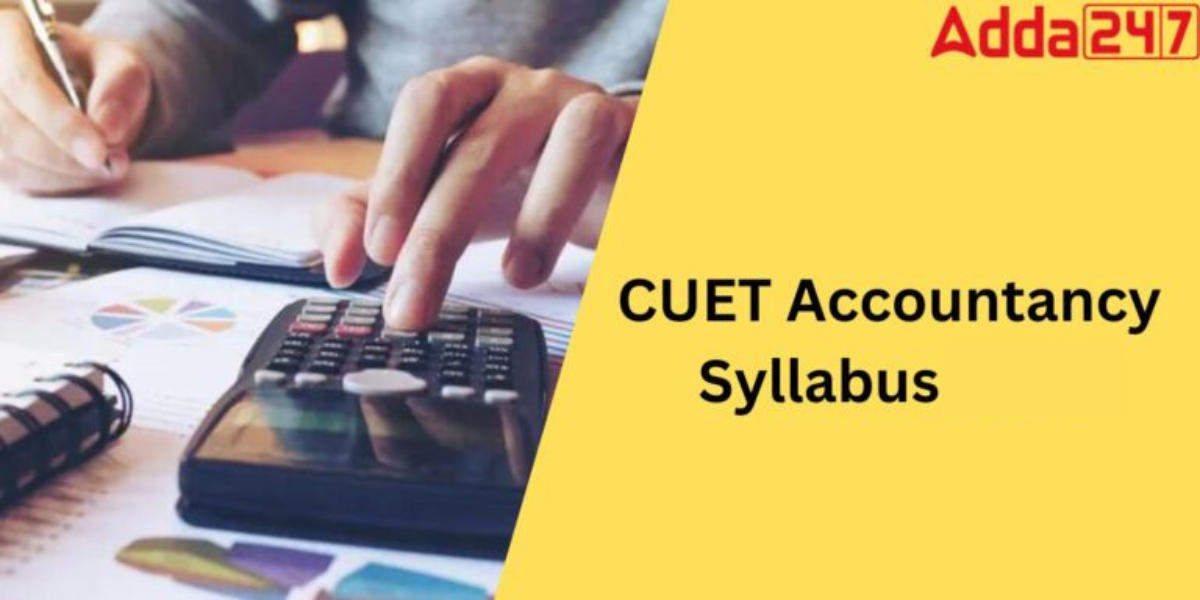Table of Contents
The National Testing Agency issues the CUET Accountancy Syllabus for the Common University Entrance Test for Undergraduates (CUET UG). Candidates can view and download the CUET Syllabus for Accounts pdf from the CUET official website, cuet.samarth.ac.in. You can also get the CUET Accountancy Syllabus PDF, exam pattern, preparation books, and Accountancy previous year question paper from this page. The CUET 2025 Syllabus contains all of the units that will be covered in the CUET Accountancy exam.
CUET Accountancy Syllabus 2025
Understanding the CUET Accountancy Syllabus 2025 is the pillar for candidates who want to pursue higher education in the Accountancy domain. Along with the General CUET Syllabus, CUET applicants in the Accountancy area must thoroughly review the CUET UG Accounts Syllabus before beginning the complete phase of CUET preparation.
CUET Accountancy Syllabus Overview
The Common University Entrance Test (CUET) 2025 is held for students who are pursuing undergraduate admission to Central Universities. There are three sections in the CUET Accounts Exam Pattern 2025. Sections 1A and 1B cover General and Special Languages, Section II covers 27 Domain-specific Subjects, and Section III covers the General Test.
The CUET Section II comprises examinations on all domain-specific subjects. Accountancy is covered in Section II. Accountancy question papers have 50 questions, all 50 questions must be answered. The CUET Accountancy 2025 exam has a total of 250 marks.
CUET Previous Year Question Paper
CUET Syllabus for Accounts Unit Wise
The CUET Accounts syllabus 2025 is divided into 11 units. Each of these 11 units is made up of multiple sub-sections that are practically equally important in the paper. Part 1 (including 1A and 1B) has seven portions, and Part 2 has four sections. Units that are included in the CUET Syllabus for Accounts 2025 are.
- Accounting for Not-for-Profit Organizations and Partnership Firms
Unit I: Accounting Not-for-Profit Organization
Unit II: Accounting for Partnership
Unit III: Reconstitution of Partnership
Unit IV: Dissolution of Partnership Firm - Company Accounts and Financial Statement Analysis
Unit V: Accounting for Share and Debenture Capital
Unit VI: Analysis of Financial Statements
Unit VII: Statement of Changes in Financial Position - Computerized Accounting System
Unit I: Overview of Computerized Accounting System
Unit II: Using Computerized Accounting System
Unit III: Accounting Using Database Management System (DBMS)
Unit IV: Accounting Applications of Electronic Spreadsheet
CUET UG Accountancy Exam Pattern
The following table includes the key details of the CUET Syllabus for Accountancy and its Exam pattern.
| CUET Accountancy Syllabus and Exam Pattern 2025 Overview | |
| Exam conducting body | National Testing Agency |
| Examination Name | Common Universities Entrance Test (CUET 2025) |
| Medium of Examination | 13 Languages (English, Kannada, Hindi, Punjabi, Marathi, Tamil, Urdu, Malayalam Odia, Assamese Telugu, Bengali and Gujarati ) |
| Examination Mode | Computer-based Test (CBT) |
| Time allotted for Accountancy Exam | 60 minutes |
| Total number of questions in the Accountancy section | 50 questions |
| Total Accountancy Questions to be Answered | 50 questions |
| Total Marks in Accountancy Section | 250 Marks |
| Marking Scheme | Marks per correct answer: +5 Marks per the wrong answer: -1 Marks per unanswered questions: 0 |
Accounts CUET Syllabus 2025 (Detailed)
Accounting is the measurement, processing, and distribution of both financial and non-financial data concerning economic entities, such as corporations and businesses. The foundation for those who intend to continue higher education in accounting is understanding the CUET syllabus for Accountancy 2025. Below, we shall go into detail about each of the 11 units of the CUET Accountancy Syllabus.
Part 1 A: Accounting for Not-for-Profit Organisations and Partnership Firms
Unit I: Accounting Not-for-Profit Organisation
• Not-for-profit organization: Meaning and Examples.
• Receipts and Payments: Meaning and Concept of fund-based and non-fund-based accounting.
• Preparation of Income and Expenditure Account and Balance sheet from receipt and payment account with additional information.
Unit II: Accounting for Partnership
• Nature of Partnership Firm: Partnership deed (meaning, importance).
• Final Accounts of Partnership: Fixed v/s Fluctuating capital, Division of profit among partners, Profit, and Loss Appropriation account.
Unit III: Reconstitution of Partnership
Changes in profit sharing ratio among the existing partners – Sacrificing ratio and Gaining ratio.
• Accounting for Revaluation of Assets and Liabilities and Distribution of reserves and
accumulated profits.
• Goodwill: Nature, Factors affecting and Methods of valuation: Average profit, Super profit,
Multiplier, and Capitalisation methods.
• Admission of a Partner: Effect of admission of a partner, Change in profit sharing ratio, the
Accounting treatment for goodwill, Revaluation of assets and liabilities, Reserves (accumulated
profits), and Adjustment of capital.
• Retirement/Death of a Partner: Change in profit sharing ratio, Accounting treatment of
goodwill, Revaluation of assets and liabilities, Adjustment of accumulated profits (Reserves).
Unit IV: Dissolution of Partnership Firm
• Meaning, Settlement of accounts: Preparation of realization account and related accounts
(excluding piecemeal distribution, sale to a company, and insolvency of a Spartner)
Part 1 B: Company Accounts and Financial Statement Analysis
Unit V: Accounting for Share and Debenture Capital
• Share Capital: Meaning, Nature, and Types.
• Accounting for Share Capital: Issue and Allotment of Equity and Preference Shares; Over
subscription and Under subscription; Issue at par, premium, and at discount; Calls in advance, Calls in arrears, Issue of shares for consideration other than cash.
• Forfeiture of Shares: Accounting treatment, Re-issue of forfeited shares.
• Presentation of shares and Debentures Capital in the company’s balance sheet.
• Issue of Debenture – At par, premium, and discount; Issue of debentures for consideration other than cash.
• Redemption of the debenture.
• Out of proceeds of fresh issue, accumulated profits, and sinking fund.
Unit VI: Analysis of Financial Statements
• Financial Statements of a Company: Preparation of simple financial statements of a company in the prescribed form with major headings only.
• Financial Analysis: Meaning, Significance, Purpose, Limitations.
• Tools for Financial Analysis: Comparative statements, Common size statements.
• Accounting Ratios: Meaning and Objectives, Types of ratios: Liquidity Ratios: Current ratio, Liquidity ratio. Solvency Ratio: Debt to equity, Total assets to debt, Proprietary ratio.
Activity Ratio: Inventory turnover, Debtors turnover, Payables turnover, Working capital
turnover, Fixed assets turnover, Current assets turnover. Profitability Ratio: Gross profit, Operating ratio, Net profit ratio, Return on Investment, Earnings per Share, Dividend per Share, Profit Earning ratio.
Unit VII: Statement of Changes in Financial Position
• Cash Flow Statement: Meaning and Objectives, Preparation, Adjustments related to depreciation, dividend and tax, sale and purchase of non-current assets (as per revised standard issued by ICAI).
Part 2: Computerized Accounting System
Unit I: Overview of Computerised Accounting System
• Concept and Types of Computerised Accounting System (CAS).
• Features of a Computerised Accounting System.
• Structure of a Computerised Accounting System.
Unit II: Using a Computerised Accounting System
• Steps in the installation of CAS, Preparation of chart of accounts, Codification, and Hierarchy of account heads.
• Data entry, Data validation, and Data verification.
• Adjusting Entries, Preparation of financial statements, Closing entries, and Opening entries.
• Security of CAS and Security features are generally available in CAS (Students are expected
to understand and practice the entire accounting process using an accounting package.)
Unit III: Accounting Using Database Management System (DBMS)
• Concepts of DBMS Objects in DBMS: Tables, Queries, Forms, Reports.
• Creating data tables for accounting.
• Using queries, forms, and reports for generating accounting information. Applications of DBMS in generating accounting information such as shareholders’ records, sales reports, customers’ profiles, suppliers’ profiles payroll, employees’ profiles, and petty cash registers.
Unit IV: Accounting Applications of Electronic Spreadsheets
• Concept of an Electronic Spreadsheet (ES).
• Features offered by Electronic Spreadsheet.
• Applications of Electronic Spreadsheet in generating accounting information, preparing
depreciation schedules, loan repayment schedules, payroll accounting, and other such company
CUET Accountancy Syllabus Pdf Download
CUET Accountancy Syllabus pdf is available on the official website of CUET i.e cuet. samarth. ac.in. Candidates can download the CUET Accountancy Syllabus 2025 pdf from the official site. For the benefits, here have provided the CUET Accountancy Syllabus pdf in the below link.
CUET Accountancy Books 2025
To secure good marks in the CUET Accountancy Exam, you need to study some reference books along with standard books, Here our Adda247 CUET Faculties refer you to some good reference books for the CUET Accountancy Syllabus.
- Accountancy I and II (Class XI and XII NCERTs)
- Handbook of Accountancy by Arihant Publication




 Bihar Board 12th Result 2025 Out @ inter...
Bihar Board 12th Result 2025 Out @ inter...
 Scoring 900+ in CUET is More Than Possib...
Scoring 900+ in CUET is More Than Possib...
 [LIVE] AP Inter Results 2025 Out, Manaba...
[LIVE] AP Inter Results 2025 Out, Manaba...




